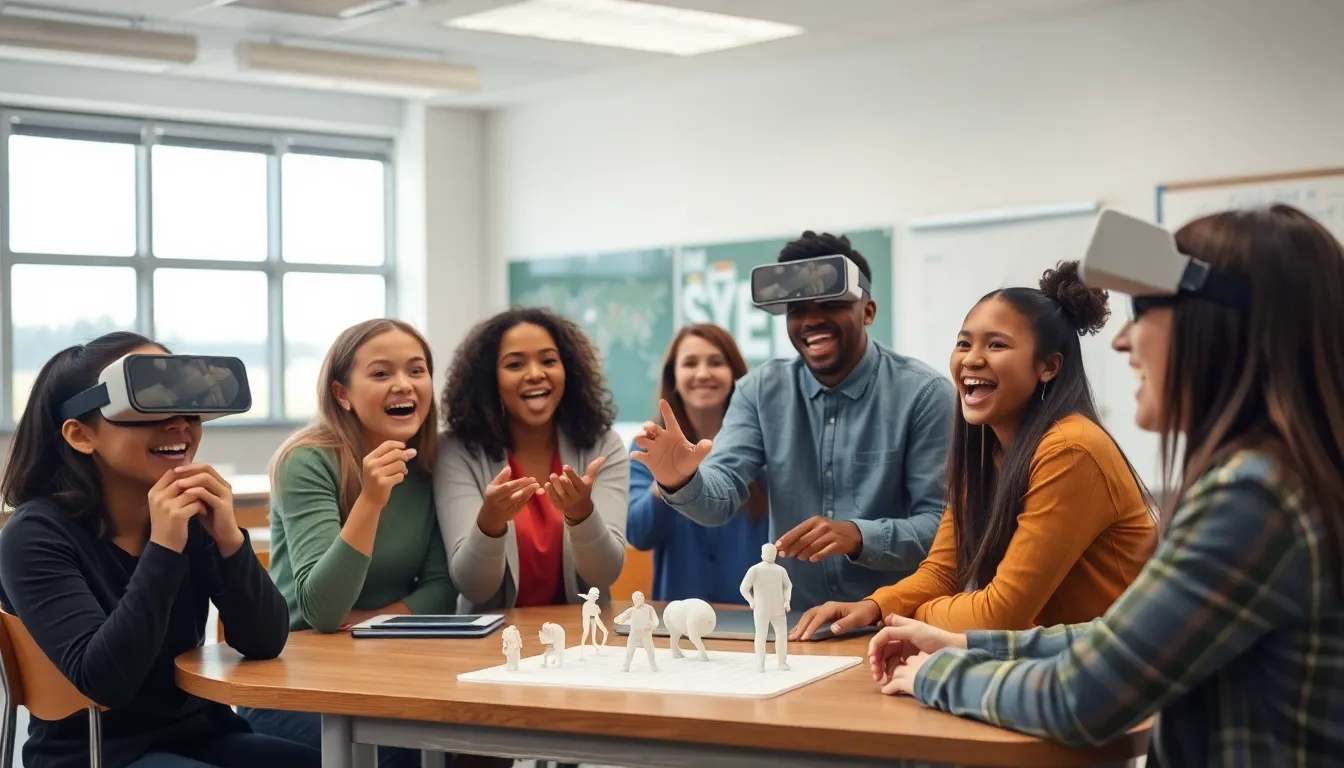Imagine walking through your living room and suddenly spotting a dinosaur lounging on your couch. Sounds wild, right? Welcome to the world of augmented reality technology, where the line between the digital and physical blurs in the most entertaining ways. This innovative tech isn’t just for gamers or sci-fi enthusiasts; it’s transforming how we interact with our environment, enhancing everything from shopping to education.
Table of Contents
ToggleOverview of Augmented Reality Technology
Augmented reality technology enhances the real world by overlaying digital information onto physical environments. This technology utilizes devices such as smartphones, tablets, and smart glasses to display virtual elements that interact with users’ surroundings.
Users experience augmented reality through various applications, demonstrating its significance in multiple fields. For instance, retail businesses implement AR apps to allow customers to visualize products before purchase, aiding decision-making. In education, AR creates immersive learning environments that engage students by bringing textbooks to life with interactive graphics.
Statistics show significant growth in the AR market, with projections reaching $198 billion by 2025. Companies increasingly invest in AR for marketing campaigns and training programs, recognizing its potential to improve customer experiences and employee performance.
Real estate agents leverage AR tools to provide virtual property tours, enabling potential buyers to explore homes remotely. Additionally, healthcare professionals integrate AR for surgical training, allowing students to practice procedures in a safe, simulated environment.
Industries that adopt augmented reality technology can enhance efficiency and user engagement. Overall, AR’s impact on everyday life continues to expand, bridging gaps between physical and digital interactions. As its applications evolve, augmented reality technology increasingly shapes consumer behavior and industry standards.
Applications of Augmented Reality Technology

Augmented reality technology finds diverse applications across various industries. This innovation reshapes experiences and enhances real-world interactions with digital elements.
In Education
AR technology transforms education by creating immersive learning environments. Students engage with interactive content, like 3D models or simulations, which fosters deeper understanding. Teachers can utilize AR applications to visualize complex subjects, such as anatomy or astronomy. For instance, students can explore the solar system or dissect virtual frogs, enhancing their grasp of concepts. Reports show that AR improves retention rates, sparking curiosity and motivation among learners.
In Healthcare
In healthcare, AR technology improves training and surgical procedures. Surgeons can overlay digital information onto the physical world during operations, improving precision. Medical students benefit from AR simulations that replicate real-life scenarios for hands-on experience. Research indicates that AR reduces error rates during surgeries, leading to better patient outcomes. Hospitals increasingly adopt AR for anatomical visualization, allowing professionals to see internal structures more clearly while diagnosing conditions.
In Retail
Retailers leverage AR technology to enhance the shopping experience. Customers can visualize products in their own environment before making a purchase. For example, furniture retailers offer AR apps that allow users to place virtual furniture in their homes, helping them envision how items fit within their space. According to surveys, consumers are more likely to buy when they can interact with products virtually. Additionally, AR provides retailers with valuable insights into customer preferences, driving more personalized marketing efforts.
Benefits of Augmented Reality Technology
Augmented reality technology offers numerous advantages across different sectors. Its ability to enhance experiences significantly transforms user interactions.
Enhanced User Experience
Enhanced user experience stands as a primary benefit of augmented reality. Users gain the ability to interact with digital elements in real-time, making environments more engaging. AR applications allow users to visualize products in their own space before making a purchase decision. An example includes furniture retailers using AR to help customers see how items fit into their homes. This immersive interaction leads to informed choices, increasing satisfaction and reducing return rates.
Improved Engagement
Improved engagement captures attention more effectively than traditional methods. AR technology delivers interactive content that captivates users. For instance, educational apps leverage AR to present complex concepts through immersive 3D models. These experiences help students grasp difficult subjects, fostering deeper learning. The active participation encouraged by AR leads to higher retention rates, resulting in a more dynamic educational environment.
Accessibility Features
Accessibility features of augmented reality enhance inclusivity for users with disabilities. AR tools can provide real-time translations for those with hearing impairments through visual cues. Similarly, navigation apps assist visually impaired users by offering auditory guidance and environmental information. As a result, AR becomes a bridge that connects diverse users, creating experiences that accommodate varying needs. This commitment to accessibility not only fosters a sense of community but also expands customer bases across industries.
Challenges and Limitations
Augmented reality technology, while innovative, faces several challenges and limitations that hinder widespread adoption.
Technical Constraints
Technical constraints significantly impact AR’s effectiveness. Hardware limitations often restrict the responsiveness and quality of AR experiences. Many devices struggle with processing power, which can lead to lag in displaying digital content. Furthermore, the need for precise tracking can pose challenges in fluctuating environments, affecting user experience. Limited battery life in mobile devices can also curtail extended AR usage. Despite advancements, ensuring seamless integration between digital overlays and the real world remains a complex task that developers continue to navigate.
Privacy Concerns
Privacy concerns represent another barrier to AR adoption. Users may feel hesitant about sharing their personal data with AR applications, fearing misuse of sensitive information. Many AR devices, particularly those capable of capturing images and videos, raise questions about surveillance and consent. As companies collect vast amounts of data to enhance user experiences, any data breaches could lead to significant trust issues. Ensuring robust data protection measures is crucial for establishing user confidence and driving future AR engagement.
Future Trends in Augmented Reality Technology
Growth in augmented reality technology continues on an upward trajectory. By 2025, the market is projected to reach $198 billion, highlighting increased investment across sectors. Many industries intend to harness AR for innovative applications, including retail, healthcare, and education.
In retail, enhanced virtual shopping experiences are on the horizon. Expect AR to create more immersive environments, allowing consumers to visualize products in real time within their personal spaces. Integration of AI into AR applications promises tailored experiences, catering to individual preferences and shopping behaviors.
Healthcare professionals will further adopt AR for training and surgical procedures. Advanced simulations are likely to offer realistic scenarios, improving surgical skills and decision-making processes. Increased accuracy in overlaying digital information during surgeries can lead to better patient outcomes.
Education is also poised for significant advances through AR. Enhanced interactive learning tools will facilitate deeper understanding, enabling students to engage with 3D models. Future classroom experiences aim to blend virtual and physical elements seamlessly, stimulating creativity and collaboration.
With these advancements, addressing ethical considerations remains critical. Data privacy and security measures must evolve alongside technological growth to maintain user trust. Ensuring robust data protection protocols will be essential for fostering broader acceptance of AR technology.
Users can anticipate more accessible AR experiences as platforms seek inclusivity. Enhanced features for individuals with disabilities aim to provide equal opportunities and foster community. Continuous innovation in AR technology will inevitably shape future interactions and redefine user experiences across multiple sectors.
Augmented reality technology is reshaping how individuals interact with their environments. Its applications span multiple industries from retail to healthcare and education. As AR continues to evolve it promises to enhance user experiences and foster deeper engagement.
The potential for growth in this sector is immense with projections indicating significant market expansion. Addressing challenges such as privacy and technical limitations will be crucial for widespread adoption.
Ultimately AR is not just a fleeting trend; it’s a transformative force that’s redefining interactions and creating new opportunities across various fields. As businesses and consumers embrace AR the future looks bright for this innovative technology.








